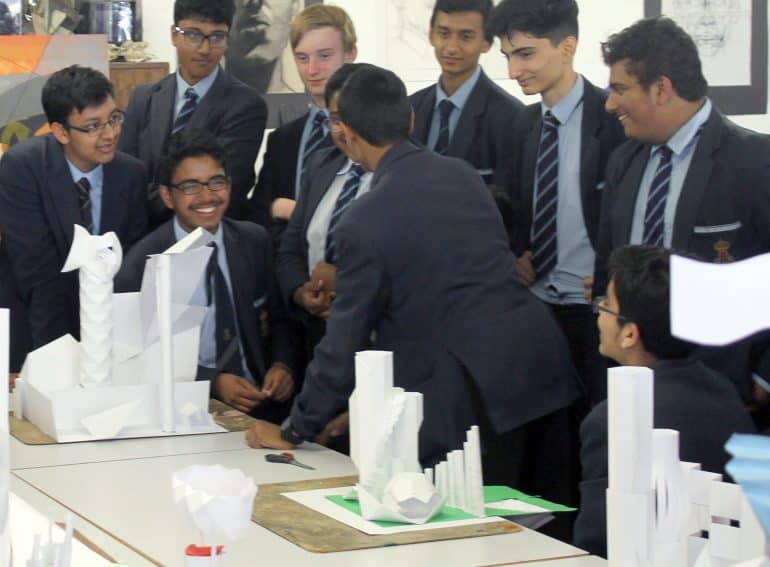
A contemporary take on a beach house took first prize in a Year 10 competition overseen by Cambridge Architecture student Danny Martin.
Old Elizabethan Danny, who has completed his second year at King’s College, helped out over the two days of the architectural modelling competition and judged the entries at the end of each day.
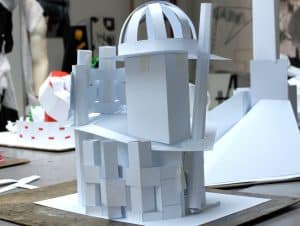 All 180 members of Year 10 were involved in the competition, which was held by the Art department as part of QE’s Enrichment Week.
All 180 members of Year 10 were involved in the competition, which was held by the Art department as part of QE’s Enrichment Week.
Afterwards, Danny said: “The ingenuity and creativity from all groups was fantastic. I’m inspired and encouraged by the quality of all the outcomes over the two days.”
The boys were divided into teams of six and given the task of constructing 3D architectural models using only card, paper, tracing paper, pins and paper clips.
The competition rules stipulated that the constructions:
- Were to be of a contemporary design, playing with the idea of abstract shapes, negative space, light and line
- Should be structurally sound (free-standing)
- Should be no bigger than 60 cm in height, depth or width
- Could take the form of wearable architecture.
Each group was expected to work as a team and to appoint a designer and project manager, as well as assigning specific tasks, such as origami-making.
Pupils were encouraged to be innovative, creative and visionary, while also setting out the function or purpose of their model and the reason they had for creating it.
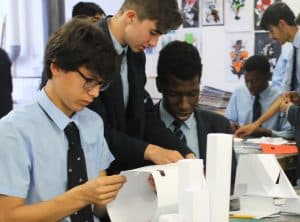 The entries created over the two days included models of museums, airports and mosques.
The entries created over the two days included models of museums, airports and mosques.
The overall winners came from Harrisons’ House. The team comprised: Vishruth Dhamodharan; Alan Gatehouse; Raheel Kapasi; Yuvraj Manral; Aiden Smith and Yuto Watanabe. They were commended for the design and construction of their model.
Head of Art Stephen Buckeridge said: “It conveyed the idea of a contemporary beach house and courtyard, utilising light and space in an innovative and creative way. The group worked exceptionally well as a team; they were calm and methodical, and had a clear vision for the outcome. The project management and construction displayed a range of skills, including paper-weaving, origami and nets constructed with mathematical precision.”

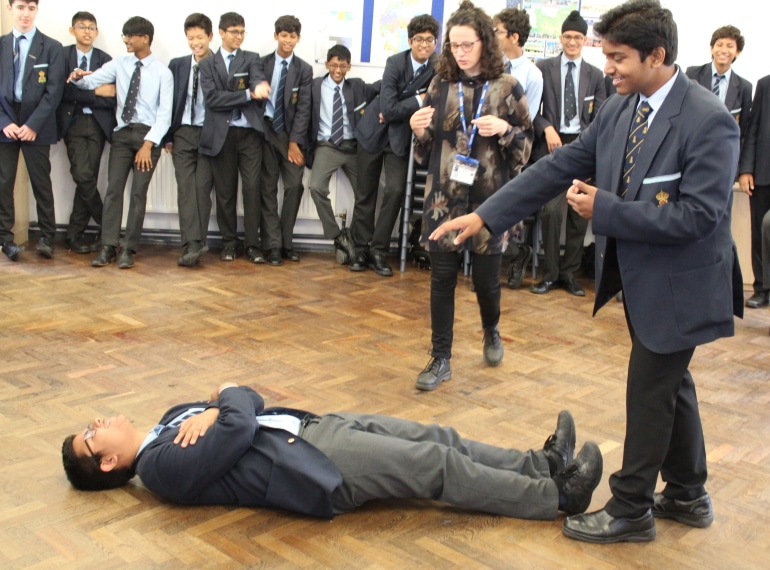
 Featuring a series of interactive workshops, the day brought to life Shakespeare’s brooding and exciting tragedy, which most of Year 9 had studied – from a purely textual point of view – earlier in the year.
Featuring a series of interactive workshops, the day brought to life Shakespeare’s brooding and exciting tragedy, which most of Year 9 had studied – from a purely textual point of view – earlier in the year. Mahmudur’s fellow Underne House member, Varun Maheswaran, said: “It was a fun day. When we played out the Macbeth scenes, it was enjoyable to explore the play in an interactive way.”
Mahmudur’s fellow Underne House member, Varun Maheswaran, said: “It was a fun day. When we played out the Macbeth scenes, it was enjoyable to explore the play in an interactive way.”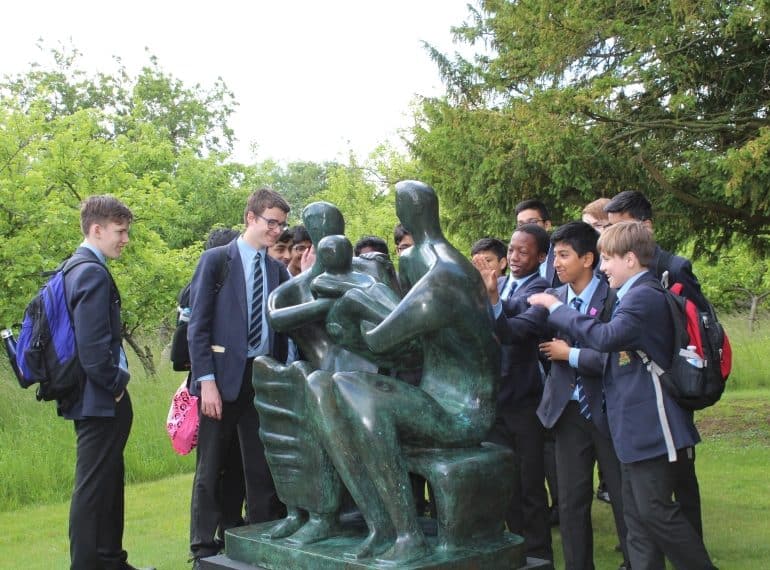
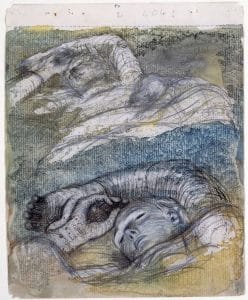 Not only did the Art trip give the pupils an opportunity to experience his spectacular outdoor sculptures in the beautiful grounds near Much Hadham, but they were also able to see the largest exhibition of his drawings in more than 40 years.
Not only did the Art trip give the pupils an opportunity to experience his spectacular outdoor sculptures in the beautiful grounds near Much Hadham, but they were also able to see the largest exhibition of his drawings in more than 40 years.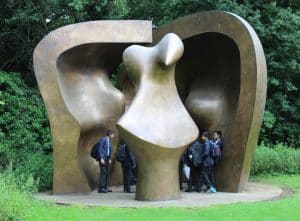 “The foundation displays a fantastic collection of his sculptural work. The students were taken on a tour of the grounds by informative guides who described the inspiration and construction behind these iconic pieces,” said Mrs McAteer.
“The foundation displays a fantastic collection of his sculptural work. The students were taken on a tour of the grounds by informative guides who described the inspiration and construction behind these iconic pieces,” said Mrs McAteer.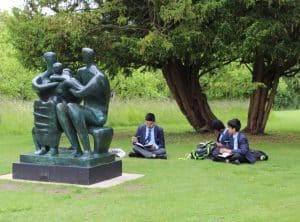 The trip began with a tour of Moore’s larger sculptures, before the group ventured inside his numerous workshops to look at his smaller, finer work. Here, said Sai, they picked up tips for improving their own sculpting, such as incorporating the appearance of bones and using textures inspired by nature, such as bark.
The trip began with a tour of Moore’s larger sculptures, before the group ventured inside his numerous workshops to look at his smaller, finer work. Here, said Sai, they picked up tips for improving their own sculpting, such as incorporating the appearance of bones and using textures inspired by nature, such as bark.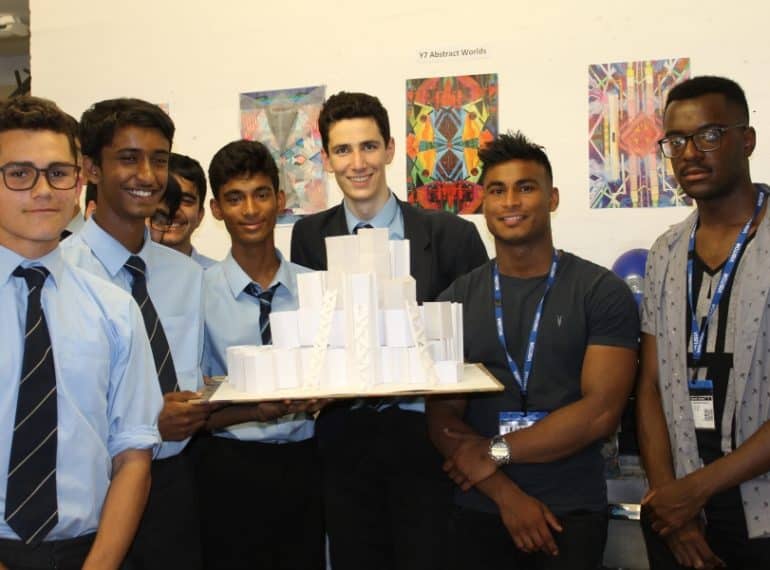
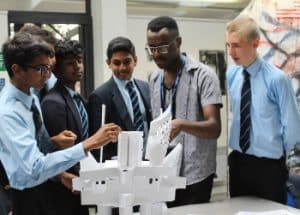 Two of 2017’s Year 13 leavers, Nabil Haque and Tochi Onuora, who are both studying Architecture at Cambridge, came back to help.
Two of 2017’s Year 13 leavers, Nabil Haque and Tochi Onuora, who are both studying Architecture at Cambridge, came back to help.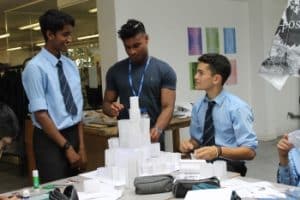 The pieces were judged at the end of the event. The Stapylton House team – comprising Alex Aliev, Nikhil Gulshan, Rakul Maheswaran, Jack Runchman, Aqif Choudhury, Riaz Kalim and Jude Miranda – won overall. Their contribution was praised for the way that it essentially used the same hexagonal shape repeatedly to build up the structure and create something very stable, yet still architecturally interesting.
The pieces were judged at the end of the event. The Stapylton House team – comprising Alex Aliev, Nikhil Gulshan, Rakul Maheswaran, Jack Runchman, Aqif Choudhury, Riaz Kalim and Jude Miranda – won overall. Their contribution was praised for the way that it essentially used the same hexagonal shape repeatedly to build up the structure and create something very stable, yet still architecturally interesting.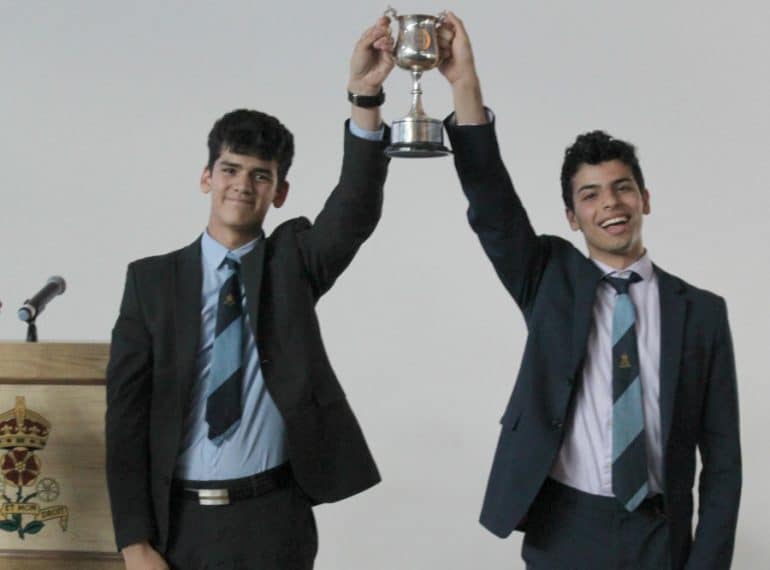
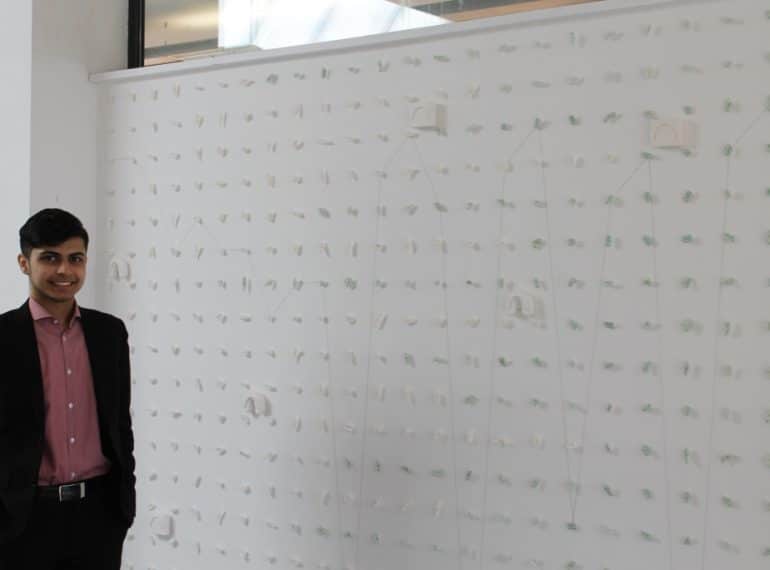
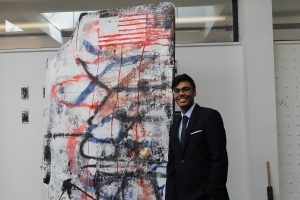 Darsh is going on to study Dentistry and his project explores the division between the personal and the clinical spheres. He employed a range of contrasting materials, including plaster of Paris casts, string, nails and even chewing gum.
Darsh is going on to study Dentistry and his project explores the division between the personal and the clinical spheres. He employed a range of contrasting materials, including plaster of Paris casts, string, nails and even chewing gum.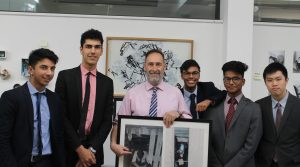 Head of Art Stephen Buckeridge said: “This year’s leavers were encouraged to find a subject that was deeply personal to them and that would sustain ideas and outcomes throughout the year. As starting a project is never easy, we encouraged the boys to record and explore ideas in the broadest sense – including note-making, research, photography, drawing and making. The breadth of investigation at the beginning was important; as the projects progressed, the ideas became more refined.”
Head of Art Stephen Buckeridge said: “This year’s leavers were encouraged to find a subject that was deeply personal to them and that would sustain ideas and outcomes throughout the year. As starting a project is never easy, we encouraged the boys to record and explore ideas in the broadest sense – including note-making, research, photography, drawing and making. The breadth of investigation at the beginning was important; as the projects progressed, the ideas became more refined.”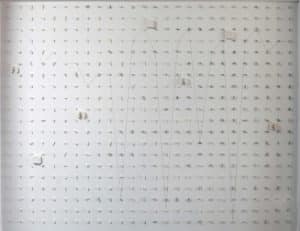 An expert panel of judges selected Darsh’s work as one of only 43 winning entries from more than 2,000 submissions by over 1,400 young artists.
An expert panel of judges selected Darsh’s work as one of only 43 winning entries from more than 2,000 submissions by over 1,400 young artists. In his explanation posted as part of the online exhibition, Darsh explained the thinking behind both his artwork and its unusual title, Savium: “I became interested in examining the link between the clinical and the personal using an unconventional material. The intimacy yet inaccessibility of the word Savium also alludes to my ulterior (and superior) interest in the dichotomy between the clinical and the personal. I became intrigued in how the personal space of the body might be examined in a forensic manner. In the end this strange display successfully evoked the fundamental tension at the heart of dentistry; that of intimacy and distance, the personal and the sterile.”
In his explanation posted as part of the online exhibition, Darsh explained the thinking behind both his artwork and its unusual title, Savium: “I became interested in examining the link between the clinical and the personal using an unconventional material. The intimacy yet inaccessibility of the word Savium also alludes to my ulterior (and superior) interest in the dichotomy between the clinical and the personal. I became intrigued in how the personal space of the body might be examined in a forensic manner. In the end this strange display successfully evoked the fundamental tension at the heart of dentistry; that of intimacy and distance, the personal and the sterile.”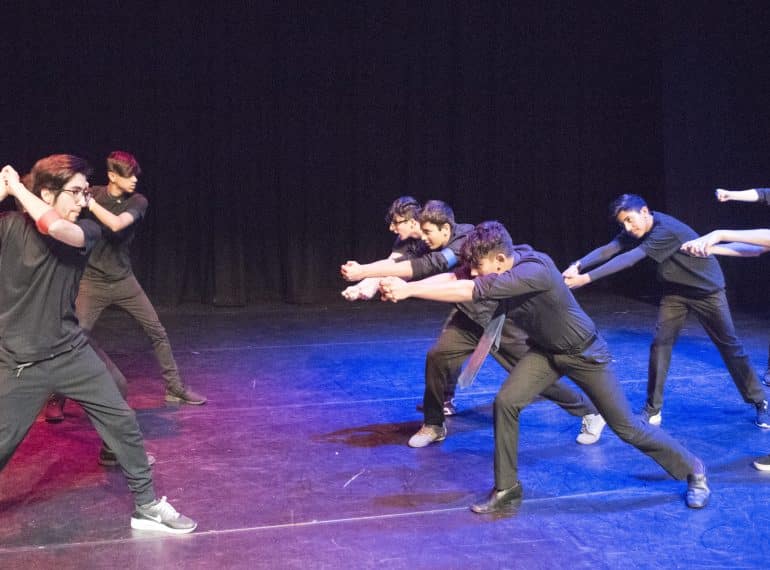
 “It can be difficult delivering Shakespearean language for the first time, but our boys learn quickly and always end that journey with a thorough understanding of their part,” said Mrs White. “Their storytelling became stronger and, by the big day the final piece was well-defined, with some solid performances.
“It can be difficult delivering Shakespearean language for the first time, but our boys learn quickly and always end that journey with a thorough understanding of their part,” said Mrs White. “Their storytelling became stronger and, by the big day the final piece was well-defined, with some solid performances. “The battle scene became one of their favourite scenes as it embodied powerful physicality and raw energy – quite daunting, especially when rehearsing in a small space!”
“The battle scene became one of their favourite scenes as it embodied powerful physicality and raw energy – quite daunting, especially when rehearsing in a small space!” Keenan Dieobi played the French king, while his fellow Year 13 pupils, Al-Fayad Qayyum and Mohit Miyanger, took the rôles of the Duke of Exeter and Fluellen respectively. Among the backstage support were 2016 leavers Miles Huglin, Shiras Patel and Alex Wingrave.
Keenan Dieobi played the French king, while his fellow Year 13 pupils, Al-Fayad Qayyum and Mohit Miyanger, took the rôles of the Duke of Exeter and Fluellen respectively. Among the backstage support were 2016 leavers Miles Huglin, Shiras Patel and Alex Wingrave.

 Headmaster Neil Enright, who watched the play alongside Chairman of Governors Barrie Martin MBE, said: “Elaine has been pivotal in making Drama once again a central part of the extra-curricular offer at QE; I am most grateful for her dedication and commitment over the years. She has brought great joy to QE’s young actors and to audiences alike.”
Headmaster Neil Enright, who watched the play alongside Chairman of Governors Barrie Martin MBE, said: “Elaine has been pivotal in making Drama once again a central part of the extra-curricular offer at QE; I am most grateful for her dedication and commitment over the years. She has brought great joy to QE’s young actors and to audiences alike.” “The 39 Steps was a fitting swansong. The production was very entertaining – it has been many years since I have laughed so much! – and highly memorable, too. It was also well-attended over the two nights. And perhaps most importantly, the boys involved seemed to thoroughly enjoy performing.
“The 39 Steps was a fitting swansong. The production was very entertaining – it has been many years since I have laughed so much! – and highly memorable, too. It was also well-attended over the two nights. And perhaps most importantly, the boys involved seemed to thoroughly enjoy performing. The 39 Steps was among the first spy thrillers ever written. Its author, who was born in Scotland in 1875, had a remarkable life which included: helping in the re-structuring of South Africa following the Boer War; working as a literary adviser for a London publishing house, and serving in the First World War firstly in the Intelligence Corps and later in the Ministry of Information, while also working as a war correspondent for The Times. After the war, he became assistant director of the British news agency, Reuters, and was the Unionist Member of Parliament for the Scottish universities, 1927–35. In 1935 he was created Baron Tweedsmuir of Elsfield and also appointed Governor-General of Canada – a post he held until his death in 1940 from a cerebral thrombosis. Buchan wrote throughout his adult life.
The 39 Steps was among the first spy thrillers ever written. Its author, who was born in Scotland in 1875, had a remarkable life which included: helping in the re-structuring of South Africa following the Boer War; working as a literary adviser for a London publishing house, and serving in the First World War firstly in the Intelligence Corps and later in the Ministry of Information, while also working as a war correspondent for The Times. After the war, he became assistant director of the British news agency, Reuters, and was the Unionist Member of Parliament for the Scottish universities, 1927–35. In 1935 he was created Baron Tweedsmuir of Elsfield and also appointed Governor-General of Canada – a post he held until his death in 1940 from a cerebral thrombosis. Buchan wrote throughout his adult life.